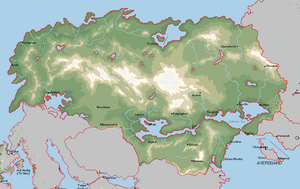Kolodoria: Difference between revisions
No edit summary |
No edit summary |
||
| Line 5: | Line 5: | ||
|common_name = Kolodoria | |common_name = Kolodoria | ||
|status = | |status = | ||
|image_flag = [[File: | |image_flag = [[File:Kolodorian Flag.png|300px]] | ||
|image_coat = | |image_coat = | ||
|alt_coat = | |alt_coat = | ||
Revision as of 01:31, 29 December 2019
Federation of Kolodoria Kolodorija | |
|---|---|
|
Flag | |
| Motto: Mēs neatlaidīgi izturēsimies. We will persevere. | |
 | |
| Capital | Salhar |
| Largest city | Strana Mechty |
| Official languages | Kolodorian |
| Demonym(s) | Kolodorian |
| Government | Unitary Presidential Constitutional Republic |
• President | Carmen Miranda's Ghost |
| Legislature | Federal Council |
| High Council | |
| Federal Assembly | |
| Area | |
• Total | 3,626,701 km2 (1,400,277 sq mi) |
| Population | |
• 2019 census | 166,170,540 |
• Density | 45.81/km2 (118.6/sq mi) |
| GDP (PPP) | estimate |
• Total | $1,857,339,400 |
• Per capita | $11,177.31 |
| GDP (nominal) | estimate |
• Total | $1,652,840,220 |
• Per capita | $9,946.65 |
| Currency | Credit |
| Driving side | right |
Kolodoria, officially the Federation of Kolodoria (originally known by it's Letnian name Kolodiya is a country in Vinya. It is bordered by Letnia to the east, Cherniya to the south-east, Vyzhva, Tír an Crainn, and Tír Tairngire in the south. It's capital is Salhar, while it's largest city is Strana Mechty. Over 70% of the country sites above 60 degrees latitude, and the northernmost parts of the country form part of the Arctic Circle. Nearly 80% of the Kolodorian population resides in urban areas.
Kolodoria was largely unpopulated outside small native settlements scattered throughout the country and Norse colonization of the far south until the Medeival Period, which saw widespread immigration from Letnia. A number of monastic orders and kingdoms sprung up through Kolodoria during this time, leading to a number of major conflicts which further developed the growing political and national identity of Kolodoria. By the 19th Century, Letnian influence had waned enough that the residual states coalesced into a single nation that would become Kolodoria. The Confederation of Kolodoria was established officially in 1843 and unevenly industrialized and developed throughout the 19th and 20th centuries. In 1940 Kolodoria went to war with Letnia and Cherniya in the Northern War, which resulted in a devestating Kolodorian defeat. A decade later, communist forces supported by Polvokia seized control of the country and established the Socialist Republic of Kolodoria. The Socialist Republic would go on to rapidly modernize much of Kolodoria, though the country was dominated by border conflicts with its neighbors. Beginning in the 1990s, the Kolodorian Communist Party began easing economic restrictions and allowing for greater privatization efforts, resulting in a largely market socialist economy.
Kolodoria is noted for its wide, frozen tundras and extensive forests and mountains in the north of the country. Kolodoria has extensive reserves of natural resources and deposits of minerals that serve a major part in the Kolodorian economy, along with manufacturing and a limited services industry.
